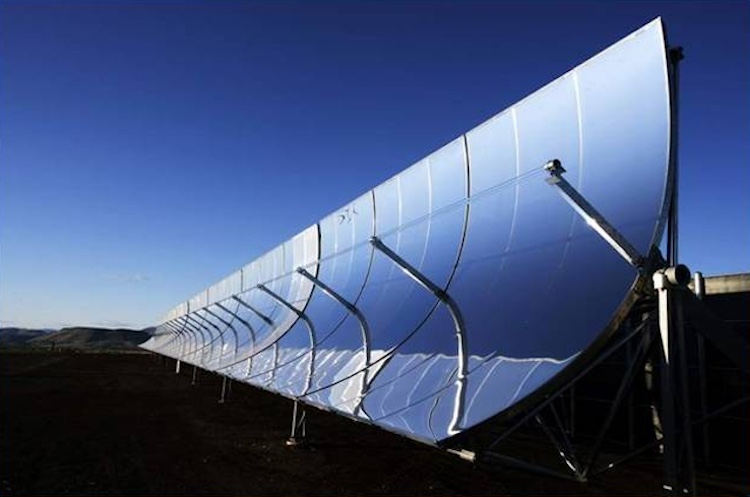A small pipe extending along the central focal point of the parabolic trough is the solar reciever in Trough CSP
Researchers have developed a completely different way for Trough CSP to collect solar energy.
Normally, in this form of Concentrated Solar Power (CSP), long lines of huge ‘trough’-shaped parabolic mirrors move slowly all day as the sun crosses the sky, to keep reflected solar flux concentrated on a stationary receiver pipe at the focal point of the parabola.
Swapping which component moves
Now, a team of international researchers has switched which component is stationary and which moves. The goal is to cut costs and reduce complexity. Their new approach would also impact Fresnel CSP, just starting to be developed in China.
In their proposal, the big parabolic mirrors would now be stationary. And the receiver, a narrow absorber pipe, would now be the part in motion.
A small slightly curved section of the parabolic mirror would be set low on the ground. To match the seasonal change in the azimuth, only its angle would be adjusted. Instead, the solar receiver would be moved through a circular path as the sun moves across the sky.
The teams tried several ways to move the pipe. Each had its advantages. Should it slide along a custom curve or rotate around a fixed point? Sliding proved lighter, and so it could be cheaper. But rotating it would give greater accuracy and stability.

Two ways to move the receiver pipe IMAGE ©Design and principle of novel linear solar concentrator with asymmetric parabolic reflector and independently movable receiver
Land use reduction
Researchers between the UK, China, and Finland collaborated on this new design to make Trough CSP cheaper, easier to maintain, and use less land. They published their paper in June at the Journal of Solar Energy Engineering: Design and principle of novel linear solar concentrator with asymmetric parabolic reflector and independently movable receiver.
In a call from the UK, lead author Song Yang explained their thinking – why moving the thin absorber pipe instead of the huge mirror is such a big deal.
“In the current setup, we space large parabolic mirror arrays apart. This is so they won’t cast shadows on each other in the morning and later afternoon,” he said.
“Sometimes, over 30% of the sunlight is lost just because of these gaps. A lot of the land is wasted. It isn’t collecting sunlight. But we can eliminate nearly all the curve of the parabolic mirror. We leave only a small section that’s almost flat on the ground, so there is no shadow.”
The team developed a mathematical model to predict performance. They focused on the deviation angle – the angle between the sun’s rays and the axis of the parabola. Their simulations showed that the best results are when the reflector is aligned east-west and tilted to the local latitude. In this setup, the deviation angle remains small for most of the year. Smaller angles result in better sunlight concentration and higher efficiency.
First prototype with small parabola and solar receiver
“We made this small mirror as a prototype,” he said. “The test shows very good agreement with the simulation. And we can take this as the preliminary validation.”
They tested it with an 850 mm (33”) parabolic mirror reflector and a 60 mm receiver pipe (about 2”). They showed that the system’s optical efficiency remained over 96% and up to 99% in the best conditions.
The new system fixes the reflector in place along an east-west line and tilts it to match the local latitude. The receiver moves along a circular path to catch the focused sunlight as the sun moves through the sky. The mirror is stationary. So you don’t need heavy equipment to move the mirrors.
When big mirrors have to move all day to track the sun, it requires more motors and more maintenance. It means higher costs. By swapping which component moves, this innovation cuts those costs. And you can put the units closer together, making the most of the available land.
The team is hoping to secure funding for the next step, which involves examining the flow of heat and liquids. In this step, they will assess how well it performs outdoors in sunlight and see if there are more ways to cut costs.
Related:
A novel solar tech for commercial heat deploys graphene nanoparticles in clear glass tubing
World’s first high altitude Trough CSP begins operation in Tibet
EuroTrough Helped Cut Ramp-Up Time of China’s 100 MW Urat Trough CSP
DEWA inaugurates its 700 MW trough and Tower CSP project for Dubai
The post How rotating the solar receiver could cut Trough CSP land use appeared first on SolarPACES.


